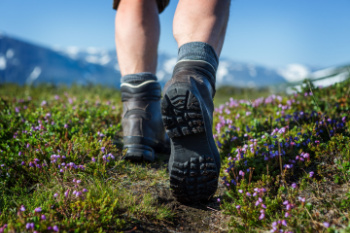Foot Care for Hikers
Tuesday, 06 August 2024 00:00 Foot care is essential for hikers to prevent common issues like blisters, overuse injuries, and fungal infections. Start by choosing well-fitted, supportive hiking boots and moisture-wicking socks to reduce friction and keep your feet dry. It is helpful to break in new boots before long hikes to avoid blisters. If blisters occur, clean them with an antiseptic and cover them with a blister pad to prevent further irritation. To guard against overuse injuries, gradually increase hiking distances and ensure proper conditioning and stretching. Pay attention to any signs of pain or discomfort and rest as needed to avoid making injuries worse. Fungal infections thrive in warm, moist environments, so keep your feet clean and dry. Change socks frequently and use antifungal powder if necessary. Let boots dry thoroughly between hikes. Regularly inspect feet for cuts, sores, or signs of infection. If you experience persistent pain, swelling, or other issues from hiking, it is suggested that you consult a podiatrist for professional advice and treatment.
Foot care is essential for hikers to prevent common issues like blisters, overuse injuries, and fungal infections. Start by choosing well-fitted, supportive hiking boots and moisture-wicking socks to reduce friction and keep your feet dry. It is helpful to break in new boots before long hikes to avoid blisters. If blisters occur, clean them with an antiseptic and cover them with a blister pad to prevent further irritation. To guard against overuse injuries, gradually increase hiking distances and ensure proper conditioning and stretching. Pay attention to any signs of pain or discomfort and rest as needed to avoid making injuries worse. Fungal infections thrive in warm, moist environments, so keep your feet clean and dry. Change socks frequently and use antifungal powder if necessary. Let boots dry thoroughly between hikes. Regularly inspect feet for cuts, sores, or signs of infection. If you experience persistent pain, swelling, or other issues from hiking, it is suggested that you consult a podiatrist for professional advice and treatment.
Ankle and foot injuries are common among athletes and in many sports. They can be caused by several problems and may be potentially serious. If you are feeling pain or think you were injured in a sporting event or when exercising, consult with Dr. Michael A. Wood from Foot Health Institute. Our doctor will assess your condition and provide you with quality foot and ankle treatment.
Common Injuries
The most common injuries that occur in sporting activities include:
- Achilles Tendonitis
- Achilles Tendon Rupture
- Ankle Sprains
- Broken Foot
- Plantar Fasciitis
- Stress Fractures
- Turf Toe
Symptoms
Symptoms vary depending upon the injury and in some cases, there may be no symptoms at all. However, in most cases, some form of symptom is experienced. Pain, aching, burning, bruising, tenderness, tightness or stiffness, sensation loss, difficulty moving, and swelling are the most common symptoms.
Treatment
Just as symptoms vary depending upon the injury, so do treatment options. A common treatment method is known as the RICE method. This method involves rest, applying ice, compression and elevating the afflicted foot or ankle. If the injury appears to be more serious, surgery might be required, such as arthroscopic or reconstructive surgery. Lastly, rehabilitation or therapy might be needed to gain full functionality in the afflicted area. Any discomfort experienced by an athlete must be evaluated by a licensed, reputable medical professional.
If you have any questions, please feel free to contact one of our offices located in Lansing, and Chicago, IL . We offer the newest diagnostic and treatment technologies for all your foot care needs.




